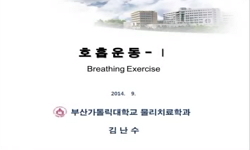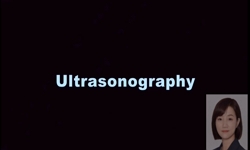Objective: The interest of clinicians is increasing due to the newly established medical insurance for pulmonary rehabilitation. Improvement of respiratory muscle strength and pulmonary function is an important factor in pulmonary rehabilitation, and ...
http://chineseinput.net/에서 pinyin(병음)방식으로 중국어를 변환할 수 있습니다.
변환된 중국어를 복사하여 사용하시면 됩니다.
- 中文 을 입력하시려면 zhongwen을 입력하시고 space를누르시면됩니다.
- 北京 을 입력하시려면 beijing을 입력하시고 space를 누르시면 됩니다.

Correlation between Respiratory Muscle Strength and Pulmonary Function with Respiratory Muscle Length Increase in Healthy Adults
한글로보기부가정보
다국어 초록 (Multilingual Abstract)
Objective: The interest of clinicians is increasing due to the newly established medical insurance for pulmonary rehabilitation. Improvement of respiratory muscle strength and pulmonary function is an important factor in pulmonary rehabilitation, and this study aims to investigate the correlation between changes in respiratory muscle contraction thickness that can affect respiratory muscle strength and pulmonary function.
Design: Cross-sectional observational study.
Methods: Thirty-one subjects (male=13, female=18) participated in this study. The respiratory muscle strength was measured by dividing it into inspiratory/forced expiratory muscles, and the pulmonary function was measured by forced vital capacity (FVC), forced expiratory volume in 1 second (FEV1), and FEV1/FVC. To evaluate the respiratory muscle length increase, in resting and concentric contraction thickness of diaphragm, external/internal oblique, transverse abdominis, and rectus abdominis were measured by using ultrasonography.
Results: Inspiratory muscle strength showed a significant correlation with the length increase of the inspiratory muscle (r=0.368 ∼0.521, p<0.05), and forced expiratory muscle strength showed a significant correlation with length increase of forced expiratory muscle (r=0.356∼0.455, p<0.05). However, pulmonary function was not correlated with the length increase of the respiratory muscle.
Conclusions: In this study, a correlation between respiratory muscle strength and respiratory muscle length increase was confirmed, but no correlation with the pulmonary function was found. It is considered that the respiratory muscle strength can be improved by increasing the respiratory muscle thickness through appropriate respiratory muscle training.
참고문헌 (Reference)
1 Harper CJ, "Variability in diaphragm motion during normal breathing, assessed with B-mode ultrasound" 43 (43): 927-931, 2013
2 Boon AJ, "Two-dimensional ultrasound imaging of the diaphragm : quantitative values in normal subjects" 47 (47): 884-889, 2013
3 Steier J, "The value of multiple tests of respiratory muscle strength" 62 (62): 975-980, 2007
4 Lutfi MF, "The physiological basis and clinical significance of lung volume measurements" 12 (12): 1-12, 2017
5 Chiang J, "Respiratory diagnostic tools in neuromuscular disease" 5 (5): 78-, 2018
6 Kaneko H, "Reduced chest and abdominal wall mobility and their relationship to lung function, respiratory muscle strength, and exercise tolerance in subjects with COPD" 61 (61): 1472-1480, 2016
7 Levine S, "Rapid disuse atrophy of diaphragm fibers in mechanically ventilated humans" 358 (358): 1327-1335, 2008
8 Amann M, "Pulmonary system limitations to endurance exercise performance in humans" 97 (97): 311-318, 2012
9 Ratnovsky A, "Mechanics of respiratory muscles" 163 : 82-89, 2008
10 Tahan N, "Measurement of superficial and deep abdominal muscle thickness : an ultrasonography study" 35 (35): 1-5, 2016
1 Harper CJ, "Variability in diaphragm motion during normal breathing, assessed with B-mode ultrasound" 43 (43): 927-931, 2013
2 Boon AJ, "Two-dimensional ultrasound imaging of the diaphragm : quantitative values in normal subjects" 47 (47): 884-889, 2013
3 Steier J, "The value of multiple tests of respiratory muscle strength" 62 (62): 975-980, 2007
4 Lutfi MF, "The physiological basis and clinical significance of lung volume measurements" 12 (12): 1-12, 2017
5 Chiang J, "Respiratory diagnostic tools in neuromuscular disease" 5 (5): 78-, 2018
6 Kaneko H, "Reduced chest and abdominal wall mobility and their relationship to lung function, respiratory muscle strength, and exercise tolerance in subjects with COPD" 61 (61): 1472-1480, 2016
7 Levine S, "Rapid disuse atrophy of diaphragm fibers in mechanically ventilated humans" 358 (358): 1327-1335, 2008
8 Amann M, "Pulmonary system limitations to endurance exercise performance in humans" 97 (97): 311-318, 2012
9 Ratnovsky A, "Mechanics of respiratory muscles" 163 : 82-89, 2008
10 Tahan N, "Measurement of superficial and deep abdominal muscle thickness : an ultrasonography study" 35 (35): 1-5, 2016
11 Schoser B, "Maximum inspiratory pressure as a clinically meaningful trial endpoint for neuromuscular diseases : a comprehensive review of the literature" 12 (12): 1-12, 2017
12 Vincken W, "Maximal static respiratory pressures in adults : normal values and their relationship to determinants of respiratory function" 23 (23): 435-439, 1987
13 De Andrade AD, "Inspiratory muscular activation during threshold®therapy in elderly healthy and patients with COPD" 15 (15): 631-639, 2005
14 Lin S-J, "Inspiratory muscle training in patients with heart failure : a systematic review" 23 (23): 29-, 2012
15 Xiao Y, "Inspiratory muscle training for the recovery of function after stroke" 2012
16 Misuri G, "In vivo ultrasound assessment of respiratory function of abdominal muscles in normal subjects" 10 (10): 2861-2867, 1997
17 Davison A, "Idiopathic diaphragmatic weakness" 304 (304): 492-, 1992
18 Cardenas LZ, "Diaphragmatic ultrasound correlates with inspiratory muscle strength and pulmonary function in healthy subjects" 44 (44): 786-793, 2018
19 Van den Berg M, "Diaphragm atrophy and weakness in the absence of mitochondrial dysfunction in the critically ill" 196 (196): 1544-1558, 2017
20 Viegi G, "Definition, epidemiology and natural history of COPD" 30 (30): 993-1013, 2007
21 Mier-Jedrzejowicz A, "Assessment of Diaphragm Weakness1-3" 137 : 877-883, 1988
22 Nici L, "American thoracic society/European respiratory society statement on pulmonary rehabilitation" 173 (173): 1390-1413, 2006
23 Stetts DM, "A rehabilitative ultrasound imaging investigation of lateral abdominal muscle thickness in healthy aging adults" 32 (32): 16-22, 2009
동일학술지(권/호) 다른 논문
-
- 물리치료재활과학회
- 하신호
- 2021
- KCI등재
-
- 물리치료재활과학회
- 손진규
- 2021
- KCI등재
-
- 물리치료재활과학회
- Han-Gyeol Lee
- 2021
- KCI등재
-
- 물리치료재활과학회
- 송준영
- 2021
- KCI등재




 ScienceON
ScienceON 스콜라
스콜라






